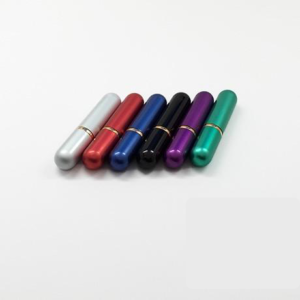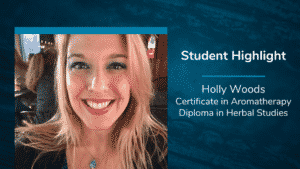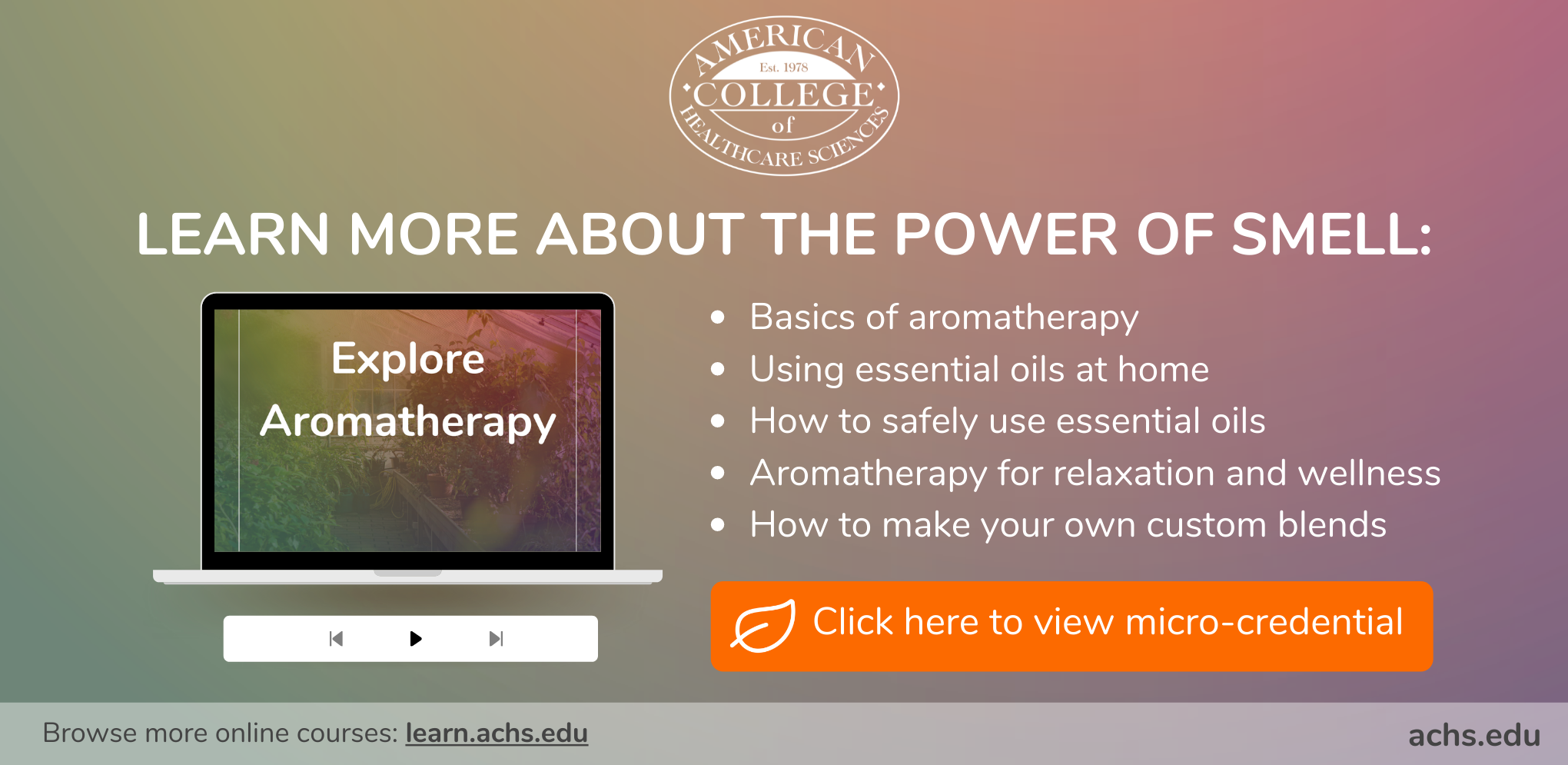
Regaining smell after COVID has become a global topic of conversation after many people have experienced temporary anosmia (loss of smell) due to COVID-19 infection. Post viral loss or impairment of the sense of smell is not new, however, and is also referred to as Postviral Olfactory Dysfunction. While we may often take our sense of smell for granted, its absence can have a huge impact on our daily lives, from our experience with food and eating, interacting with our living environment, even being able to sense danger.1 Our sense of smell gives us an incredible amount of information each day.

This has many people asking, “What can I do to help my loss of smell?”. A common approach used to support post-viral olfactory dysfunction is called olfactory training, and it really is training for your sense of smell!2 A person inhales concentrated aromas from personal inhalers or “sniffy sticks” a few times a day over a period of several weeks (around 12 weeks, some studies go longer) to give their sense of smell a workout of sorts.3 While the individual may not perceive the aromas they are inhaling or might experience a distortion of the aroma, they can focus on their memory of the aroma to encourage neural connection to the aroma.4
Typically, the individual notices a gradual change over time in their experiences during their olfactory training sessions, similar to the progressive results one might see from physio training. Research has shown olfactory training to be an effective support technique for post-viral loss of smell, but, it should be noted each situation is unique and results vary from person to person. Researchers are still working to understand how to tailor olfactory training to optimize results, but initial studies have shown there seems to be a range of effective olfactory training techniques, which is encouraging.5 6
Here is where aromatherapy enters the scene. Essential oils in personal inhalers, or “sniffy sticks”, have been used in olfactory training kits for quite some time.7 And with the increase in need for olfactory training support, aromatherapists have been a resource. Inhalation of essential oils is a safe aromatherapy application method commonly used by trained aromatherapists. Recently, ACHS alumni, Janna Setterholm, who graduated from the ACHS Diploma in Aromatherapy program with honors in 2019, had her work with essential oil olfactory training kits featured by a Fargo, ND local news station, here. For the client story featured in the new report, Setterholm used essential oils to highlight key fragrance receptor categories such as floral, citrus, spicy, and woody.8 9
Working with a trained aromatherapist to create a custom olfactory training kit creates the opportunity to choose essential oils for the individual to work with from key fragrance categories for which they also have positive memories (aroma associations) and to avoid any essential oils the individual may be allergic to or dislike. This supports the theoretical framework behind olfactory training which shows the exercises progressively build olfactory system sensitivity and increase connectivity with other important neural networks which help translate information from the sense of smell.10 While a person with anosmia may not perceive the aroma they are inhaling, this does not inhibit their ability to benefit from it, however, being able to reflect on their memories of that aroma can be supportive for them during the exercises.11
Research is still ongoing to understand how and why COVID-19 affects the olfactory system and the sense of smell.12 13 This continued research will inform best practices for how to support individuals with post-viral olfactory dysfunction from COVID-19 and may foster further innovation for how to support individuals with anosmia for other reasons.14
About the Author
Amanda Lattin, BA, MAT, Dip. Aroma., MH, RA is the Dean of Aromatherapy at ACHS. Learn more about Amanda and her aromatherapy experience online here.
Disclaimer: This article is for informational purposes only. It is not intended to treat, diagnose, cure, or prevent disease. This article has not been reviewed by the FDA. Always consult with your primary care physician or naturopathic doctor before making any significant changes to your health and wellness routine.
About American College of Healthcare Sciences
 American College founded in 1978, is a fully online accredited institute of higher education specializing in holistic health. Based in Portland, OR; our goal is to make research-driven and science-based holistic health education taught by industry-leading experts accessible to anyone anywhere while still giving students a hands-on experiential learning experience like a traditional college and a strong sense of community, school pride, and student bond.
American College founded in 1978, is a fully online accredited institute of higher education specializing in holistic health. Based in Portland, OR; our goal is to make research-driven and science-based holistic health education taught by industry-leading experts accessible to anyone anywhere while still giving students a hands-on experiential learning experience like a traditional college and a strong sense of community, school pride, and student bond.
This commitment to our students and graduates reflects in our current survey results that reflect 98% of our students would recommend ACHS to a friend or family member.
We believe education is the most powerful tool for changing an individual and the world around us.
When a person enrolls at ACHS, it is vitally important that they graduate with the tools they need to forge their own holistic and sustainable missions, build up their communities confidently, and change the face of healthcare with knowledge.
References
- Boesveldt, S., Postma, E. M., Boak, D., Welge-Luessen, A., Schöpf, V., Mainland, J. D., Martens, J., Ngai, J., & Duffy, V. B. (2017). Anosmia-A Clinical Review. Chemical senses, 42(7), 513–523. https://doi.org/
10.1093
/chemse/bjx025 - Kattar, N., Do, T. M., Unis, G. D., Migneron, M. R., Thomas, A. J., & McCoul, E. D. (2021). Olfactory Training for Postviral Olfactory Dysfunction: Systematic Review and Meta-analysis. Otolaryngology–head and neck surgery : official journal of American Academy of Otolaryngology-Head and Neck Surgery, 164(2), 244–254. https://doi.org/
10.1177/
0194599820943550 - Kollndorfer, K., Fischmeister, F. P., Kowalczyk, K., Hoche, E., Mueller, C. A., Trattnig, S., & Schöpf, V. (2015). Olfactory training induces changes in regional functional connectivity in patients with long-term smell loss. NeuroImage. Clinical, 9, 401–410. https://doi.org/
10.1016/j.nicl.2015.09.004 - Patel Z. M. (2021). Olfactory Loss and Olfactory Training. JAMA otolaryngology– head & neck surgery, 147(9), 840. https://doi.org/
10.1001/j
amaoto.2021.1507 - Patel, Z. M., Wise, S. K., & DelGaudio, J. M. (2017). Randomized Controlled Trial Demonstrating Cost-Effective Method of Olfactory Training in Clinical Practice: Essential Oils at Uncontrolled Concentration. Laryngoscope investigative otolaryngology, 2(2), 53–56. https://doi.org/
10.1002/lio2.62 - Patel Z. M. (2021). Olfactory Loss and Olfactory Training. JAMA otolaryngology– head & neck surgery, 147(9), 840. https://doi.org/
10.1001/
jamaoto.2021.1507 - Patel, Z. M., Wise, S. K., & DelGaudio, J. M. (2017). Randomized Controlled Trial Demonstrating Cost-Effective Method of Olfactory Training in Clinical Practice: Essential Oils at Uncontrolled Concentration. Laryngoscope investigative otolaryngology, 2(2), 53–56. https://doi.org/
10.1002/lio2.62 - Auffarth, B., Kaplan, B., & Lansner, A. (2011). Map formation in the olfactory bulb by axon guidance of olfactory neurons. Frontiers in systems neuroscience, 5, 84. https://doi.org/
10.3389/
fnsys.2011.00084 - Dodd, K. 202. (2021,December 30) ‘The world was sterile’: Woman says Olfactory Training Kit helped regain her sense of smell after COVID-19. Valley News Live. https://www.valleynewslive
.com/
2021/12/30/world
-was-sterile-
woman-says-olfactory-training
-kit-helped-regain-her-sense
-smell-after-covid-19/ - Kollndorfer, K., Fischmeister, F. P., Kowalczyk, K., Hoche, E., Mueller, C. A., Trattnig, S., & Schöpf, V. (2015). Olfactory training induces changes in regional functional connectivity in patients with long-term smell loss. NeuroImage. Clinical, 9, 401–410. https://doi.org/
10.1016/j.nicl.2015.09.004 - Olofsson, J. K., Ekström, I., Lindström, J., Syrjänen, E., Stigsdotter-Neely, A., Nyberg, L., Jonsson, S., & Larsson, M. (2020). Smell-Based Memory Training: Evidence of Olfactory Learning and Transfer to the Visual Domain. Chemical senses, 45(7), 593–600. https://doi.org/
10.1093/chemse/bjaa049 - Butowt, R., & von Bartheld, C. S. (2021). Anosmia in COVID-19: Underlying Mechanisms and Assessment of an Olfactory Route to Brain Infection. The Neuroscientist : a review journal bringing neurobiology, neurology and psychiatry, 27(6), 582–603. https://doi.org/
10.1177/1073858420956905 - Kandemirli, S. G., Altundag, A., Yildirim, D., Tekcan Sanli, D. E., & Saatci, O. (2021). Olfactory Bulb MRI and Paranasal Sinus CT Findings in Persistent COVID-19 Anosmia. Academic radiology, 28(1), 28–35. https://doi.org/
10.1016/j.acra.2020.10.006 - Le Bon, S. D., Konopnicki, D., Pisarski, N., Prunier, L., Lechien, J. R., & Horoi, M. (2021). Efficacy and safety of oral corticosteroids and olfactory training in the management of COVID-19-related loss of smell. European archives of oto-rhino-laryngology : official journal of the European Federation of Oto-Rhino-Laryngological Societies (EUFOS) : affiliated with the German Society for Oto-Rhino-Laryngology – Head and Neck Surgery, 278(8), 3113–3117. https://doi.org/
10.1007/s00405-020-06520-8
 President’s Message: End Of Year Reflectionsby American College of Healthcare Sciences●December 31, 2020
President’s Message: End Of Year Reflectionsby American College of Healthcare Sciences●December 31, 2020 Student Highlight: Wife and Husband Team Start New Businessby American College of Healthcare Sciences●December 22, 2020
Student Highlight: Wife and Husband Team Start New Businessby American College of Healthcare Sciences●December 22, 2020 Student Highlight: Holistic Health, Gratitude, and Smoothies |achs.eduby American College of Healthcare Sciences●December 17, 2020
Student Highlight: Holistic Health, Gratitude, and Smoothies |achs.eduby American College of Healthcare Sciences●December 17, 2020 3 Tips For Building Better Habitsby American College of Healthcare Sciences●December 10, 2020
3 Tips For Building Better Habitsby American College of Healthcare Sciences●December 10, 2020
